Table of Contents
Reading this blog post will give you a great foundation and explain how to use ai to Elevate Your Web Marketing Strategy. it’s about a 20 minute read. But if you want to lean more about ai and how to scale with ai do it.
- Understanding ai’s Role in a Modern Web Marketing Strategy
- Auditing Your Current Web Marketing Strategy Before AI Adoption
- Selecting the Right AI Tools for Your Web Marketing Strategy
- AI-Powered Content Creation & Optimization
- Personalization & Customer Segmentation with AI
- Measuring Success & Continuous Improvement in Your AI-Enhanced Web Marketing Strategy
In today’s digital landscape, artificial intelligence has become the secret weapon for marketers looking to cut through the noise and deliver data-driven, personalized experiences. This post will help you use AI in your Web Marketing Strategy.
AI is reshaping how businesses approach their web marketing strategy, from smart content generation and predictive audience segmentation to automated campaign optimization and performance tracking.
In this comprehensive guide, Slocum Design Studio walks you through each step—from auditing your current approach to choosing the right AI tools, crafting hyper-personalized content, and continuously measuring success—so you can elevate your results and drive sustainable growth.
1. Understanding ai’s Role in a Modern Web Marketing Strategy
Artificial intelligence isn’t just another tech buzzword—it’s a powerful partner that can transform your web marketing strategy from guesswork into precision-guided campaigns. In this first section, we’ll cover five essential areas:
- What is AI in Web Marketing? We’ll explain AI in simple terms and show how machine learning and algorithms power smarter decisions online.
- Evolution of ai Tools for Marketing: From basic automation to sophisticated predictive engines, you’ll see how AI platforms have grown up alongside digital marketing.
- How AI Shapes Customer Behavior Analysis: Discover how AI sifts through mountains of user data—clicks, time on page, purchase history—to map behavior patterns you can’t spot manually.
- Key Benefits of ai for Your Web Marketing Strategy: Learn about hyper-personalization, efficient budgeting, real-time optimizations, and other game-changing perks.
- Common Pitfalls & How to Avoid Them: Even the best AI tools can stumble. We’ll highlight typical traps—like poor data hygiene or over-reliance on automation—and show you how to steer clear.
Together, these topics form a 360° view of ai in action. You’ll gain foundational knowledge (What Is AI), historical context (Evolution of ai Tools), actionable insights (Customer Behavior Analysis), strategic advantages (Key Benefits), and risk mitigation tips (Common Pitfalls). This holistic understanding helps integrate ai seamlessly into your overall web marketing strategy, ensuring you harness its power without getting tripped up by unrealistic expectations or flawed implementations.
1.1 What Is ai in Web Marketing?
Artificial intelligence in web marketing refers to software systems that can analyze data, learn from patterns, and make decisions with minimal human intervention. Imagine a tool that reviews every click on your site, every email open, and social media mention, then suggests which audiences to target or what message will resonate best.
At its heart, AI combines machine learning (ML) and predictive analytics. ML algorithms train on historical data—say, past campaign performance—to predict future user behavior. Predictive analytics takes it further by estimating outcomes, such as conversion likelihood or optimal send times, based on statistical models.
In practice, ai in web marketing manifests as chatbots that answer customer queries instantly, recommendation engines that upsell products based on browsing history, and dynamic ad placement that adjusts bids in real time. These tools sift through vast datasets in seconds—something no human team could match—freeing marketers to focus on creative strategy. But ai isn’t magic. It needs high‑quality data and clear goals. When set up properly, it becomes the engine that drives precision, turning your web marketing strategy into a data‑driven, constantly optimized process that adapts as your audience evolves.
How an Edtech Startup Used AI Tools to Boost Ad Performance by 40%
- A case study on how the Ukrainian edtech startup Headway leveraged AI tools like Midjourney and HeyGen to enhance their advertising ROI.
- Read the articlebusinessinsider.com
Toys ‘R’ Us AI-Generated Ad Sparks Fear, Fascination
- An exploration of how Toys “R” Us utilized AI to create a nostalgic brand film, highlighting the blend of human creativity and AI technology.
- Read the articlenypost.com
1.2 Evolution of ai Tools for Marketing
The journey of ai tools in marketing started with simple rule‑based systems. Early email automation platforms sent messages when triggered by a specific action—like abandoning a cart—but couldn’t adjust to changing behaviors. Then came machine learning‑powered analytics tools that unearthed patterns in customer data, enabling better segmentation.
Today’s AI solutions integrate natural language processing (NLP), computer vision, and deep learning. NLP lets chatbots understand nuanced customer queries, while computer vision analyzes images for brand logos or sentiment. Deep‑learning models optimize ad spend in milliseconds, bidding up or down based on real‑time performance metrics.
This evolution mirrors advances in computing power and data storage.
Cloud platforms made processing terabytes of marketing data affordable, and APIs simplified integration between AI engines and popular marketing stacks. As a result, sophisticated tools once reserved for large enterprises are now accessible to small businesses like yours, helping you use ai to Elevate Your Web Marketing Strategy. The key takeaway: ai tools keep getting smarter and more user‑friendly. Staying current means you can leverage the latest capabilities—automated content creation or real‑time customer insights—without a PhD in data science.
1.3 How AI Shapes Customer Behavior Analysis
Customer behavior analysis used to be a tedious process of polling spreadsheets and running manual reports. AI flips that model on its head. Machine‑learning algorithms ingest clickstreams, form submissions, purchase histories, and even social‑media interactions to build dynamic user profiles. Rather than segmenting users by broad demographics, ai uncovers micro‑segments—groups defined by nuanced behaviors, like the “weekend deal hunters” or “late‑night blog readers.” These insights feed directly into your web marketing strategy, guiding targeted email campaigns, personalized website experiences, and optimized ad placements.
Moreover, predictive models can forecast future behavior—who’s likely to churn, which products a customer might buy next, or when to send a re‑engagement email. This kind of approach means you’re no longer reacting to trends after they happen; you’re anticipating needs and sending the right message at exactly the right moment. The result is higher conversion rates, improved customer loyalty, and a more efficient marketing budget allocation.
Key Benefits of AI for Your Web Marketing Strategy
- Hyper‑Personalization: AI customizes experiences at absurd scale—recommending content or products unique to each visitor.
- Real‑Time Optimization: Campaigns adjust in flight, reallocating budget to top performers automatically.
- Data‑Driven Insights: Beyond gut feelings, ai provides concrete metrics that inform every decision.
- Efficiency Gains: Routine tasks—A/B tests, reporting, even ad creative suggestions—happen in seconds, freeing your team to innovate.
- Scalability: As your business grows, AI scales with you—processing more data and running more campaigns without adding headcount.
These benefits coalesce into how to use AI to Elevate Your Web Marketing Strategy, which is lean, agile, and relentlessly focused on ROI. You get smarter targeting, better content, and continuous improvement, all powered by machines that never sleep. We couldn’t have imagine tools like this a few years ago.
Common Pitfalls & How to Avoid Them
AI isn’t a silver bullet. Common missteps include:
- Poor Data Quality: Garbage in, garbage out. Make sure your content is clean, consistent, and informative.
- No Clear Objectives: Don’t buy AI tools before defining what success looks like—set KPIs first.
- Over‑Automation: Blindly automating every task leads to robotic campaigns. Maintain human oversight for brand voice and creative nuance.
- Neglecting Privacy: AI thrives on data—make sure you comply with GDPR, CCPA, and other regulations.
- Ignoring Training: AI models need regular updates and training to stay accurate. Build a schedule for updates.
By recognizing these things early, you can smoothly integrate AI into your web marketing strategy, maximizing benefits while minimizing risks.
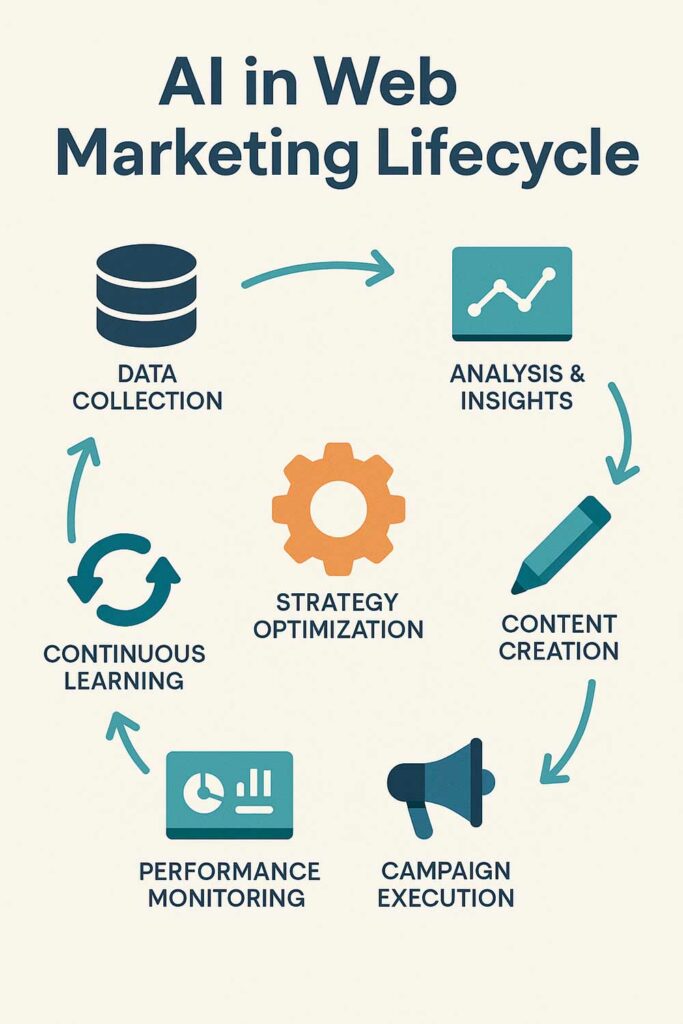
2: Auditing Your Current Web Marketing Strategy Before ai Adoption
Before you unleash ai on your campaigns, it pays to take a hard look at what you’re already running. An audit is like spring cleaning for your web marketing strategy—you clear out outdated tools, spot hidden opportunities, and lay a solid foundation for ai to build on. In this section, we’ll cover five crucial steps:
1. Mapping Existing Channels & Touchpoints
Chart how customers interact with you online—social media, email, blog, ads, landing pages. You’ll see where traffic flows and where it leaks.
2. Identifying Data Gaps
Do you have enough data? Perhaps you’re tracking visits but not conversions, or you’re blind to mobile behavior. Recognizing missing pieces helps you feed your ai models the right inputs.
3. Evaluating Content Performance Metrics
Which blog posts, emails, or ads are pulling their weight? Look at open rates, time on page, bounce rates, and conversion paths. This tells you what ai should amplify and what to retire.
4. Reviewing Customer Journey Maps
Walk in your customer’s shoes. Map each stage—from awareness to purchase to advocacy—and note where friction occurs. ai thrives when it has a clear path to optimize.
5. Securing Stakeholder Buy‑In
An ai rollout needs champions. Present your audit findings in a concise report, align on goals, and get everyone, from marketing to sales, on the same page.
Together, these five steps create a 360° snapshot of your current landscape. With clear channel maps, data gaps closed, performance insights in hand, journey maps refined, and stakeholders aligned, you’ll have the clean data and unified vision that any AI‑powered web marketing strategy demands. Let’s dive into each step, starting with mapping your channels and touchpoints.
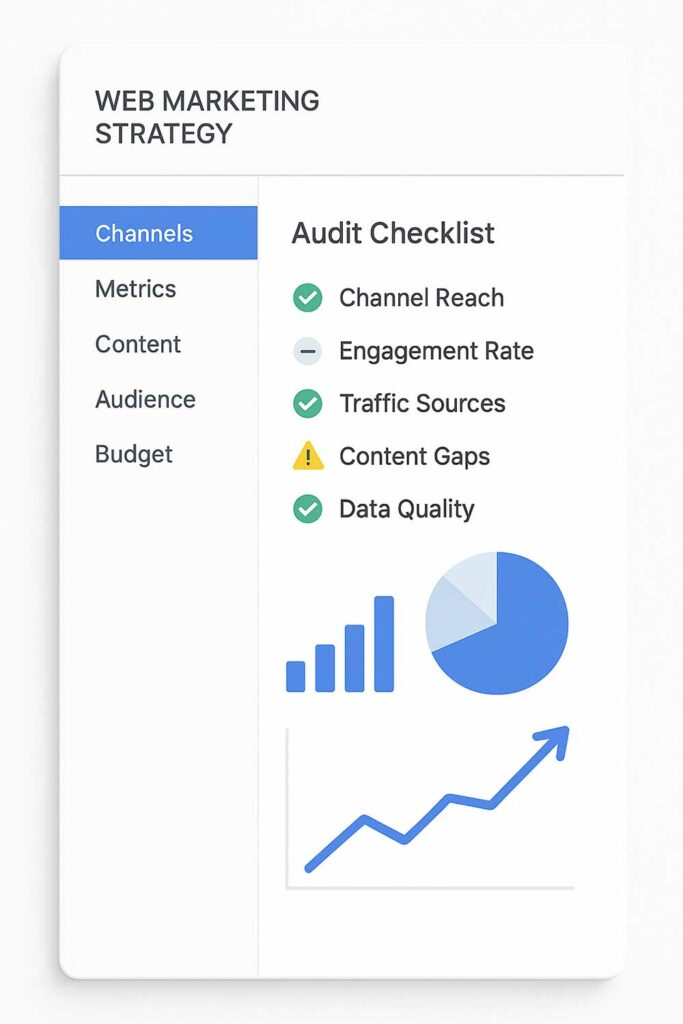
Mapping Existing Channels & Touchpoints
Imagine your marketing channels as rooms in a house. Some rooms—your blog or email list—are cluttered but cozy, packed with loyal visitors. Others—perhaps paid ads or social media—are empty and echoing. Your first task is to draw a floor plan of all these rooms.
Start by listing every channel: website, blog, email newsletters, Facebook, LinkedIn, Instagram, paid search, display ads, affiliate links, and any emerging outlets like podcasts or webinars. Under each channel, note the key touchpoints—homepage visits, blog post reads, email opens, social likes, ad clicks, form submissions, and conversions.
Next, rate each channel by traffic volume and conversion performance. Which rooms get the most foot traffic? Which ones lead guests to the checkout? This mapping reveals where your audience spends time and where you might lose them.
By the end of this exercise, you’ll have a visual guide that shows where to plug in AI. Maybe your email list needs smarter segmentation, or your paid ads need predictive bidding. Here at Slocum Studio we know this is time well spent.
Whichever way, mapping channels and touchpoints is how you use AI to elevate your web marketing strategy, which is grounded in reality, not guesswork.
Identifying Data Gaps
You wouldn’t bake a cake without key ingredients, so don’t feed AI models incomplete data. Identifying data gaps is about spotting missing metrics and flawed tracking.
Run through your analytics tools—Google Analytics, CRM reports, email platform stats—and ask: Are we capturing user demographics, session duration, click paths, and conversion events? Do we know where visitors abandon carts? Are returning visitors appropriately tagged? If you find questions you can’t answer, that’s a gap.
Next, check data quality. Sometimes tracking codes are missing on a page, or filters accidentally exclude certain traffic. Data anomalies—like spikes in referral spam—can skew your insights. Clean your analytics: remove bot traffic, fix broken event tags, and validate conversion tracking.
Filling these gaps might mean adding new tracking scripts, consistently tagging UTM parameters, or installing heat‑mapping tools. Once your data is complete and accurate, your AI tools will have the raw material they need to deliver reliable predictions and recommendations, ensuring your web marketing strategy makes decisions based on solid facts, not wishful thinking.
Evaluating Content Performance Metrics
Not all content is created equal. Evaluating performance metrics helps you prune underperformers and double down on winners. Sometimes we’re surprized by pages, blogs or products that rank or sell that we thought would not. So that’s cool–right?
Start by defining key metrics: page views, time on page, bounce rate, scroll depth, click‑through rates, and goal completions like form fills or purchases. Use your analytics dashboard to pull a content report. This is an important part when paired with the use ai in your content marketing plan.

Identify your top 10% of pages by traffic and engagement. Then look at the bottom 10%—are they outdated blog posts, poorly optimized landing pages, or mismatched ad creatives? Jot down themes: maybe how‑to articles rank well, but list posts flop.
Dig deeper with A/B tests or heat maps to understand why some content resonates. Is your headline weak? Is your call‑to‑action buried? Use these insights to guide AI‑powered content generation. For instance, AI can suggest new headlines that mirror your best performers or generate summaries of long articles to boost engagement.
When you feed AI models with high‑performing examples and flag low performers, you give them a clear signal of what success looks like. This makes your web marketing strategy more efficient and content-driven than shooting arrows in the dark.
Reviewing Customer Journey Maps
Customer Journey Map stages: Awareness, Consideration, Purchase, Retention, Advocacy.
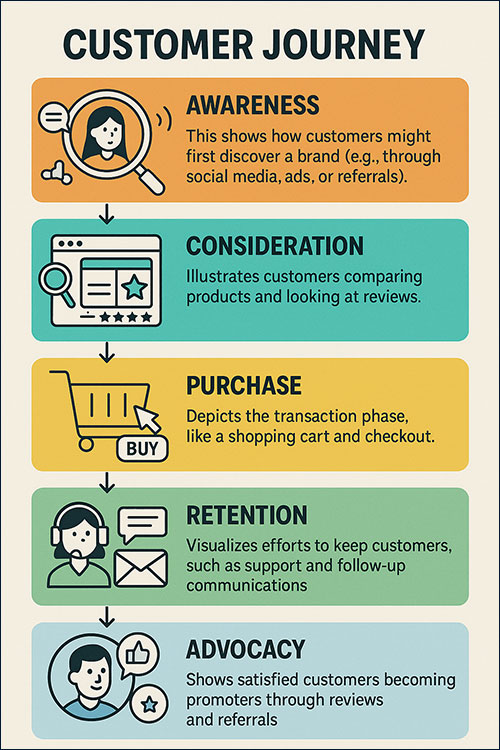
Your customer’s journey is a storyline from “Who are you?” to “Yes, I’ll buy!” Reviewing journey maps helps you spot plot holes. Sketch out each stage: Awareness, Consideration, Purchase, Retention, Advocacy.
At the Awareness stage, note channels where prospects first hear of you—social posts, referrals, ads. In Consideration, they compare offerings and read reviews. Purchase involves cart and checkout experiences. Retention covers support and follow-up emails. Advocacy captures reviews and referrals.
For each stage, record emotions and friction points. Do prospects drop off after the first click? Is pricing unclear? Does your checkout page lag? Color‑code urgent fixes in red.
Once the map is polished, you’ll know where ai can help. Use chatbots to answer real-time questions, predictive models to send reminder emails when carts are abandoned, and personalization engines to show related products post‑purchase. This step-by-step view ensures your AI enhancements fit into the web marketing strategy narrative, closing gaps and smoothing the path to conversion.
Securing Stakeholder Buy‑In
Introducing ai isn’t a solo mission. Your acceptance from marketing, sales, IT, and leadership to secure a budget, data access, and ongoing support.
Start by presenting your audit findings in a concise slide deck: channel maps, data gaps, content wins and losses, journey pain points. Use simple charts and call out quick wins AI could deliver—like boosting email open rates by 20% with subject‑line optimization.
Next, align on clear objectives: increased lead quality, reduced ad spend waste, faster content production. Show projected ROI based on industry benchmarks or pilot results. Invite key stakeholders to a workshop where you demo a simple AI tool—perhaps a chatbot or headline generator—to illustrate instant impact.
Finally, set up a governance plan: data ownership, model evaluation schedule, and roles for oversight. When everyone sees the value, vibe, and safeguards, you’ve earned the backing to integrate ai into your web marketing strategy.
3: Selecting the Right ai Tools for Your Web Marketing Strategy
Together, these five H3 topics ensure you don’t just grab the shiniest AI toy, but choose solutions that slot seamlessly into your existing web marketing strategy, deliver measurable impact, and scale as you grow. Ready to build your ai toolbox? Let’s dive deeper.
- Defining Your Evaluation Criteria
Before you thumb through vendor catalogs, list exactly what you need: realistic budget caps, must‑have features (like natural language processing or predictive analytics), ease of use, and how well a tool fits into your existing tech stack. - Categories of ai Solutions
AI for your web marketing strategy comes in all shapes: chatbots and virtual assistants, predictive analytics engines, content‑generation platforms, social‑listening tools, and automated ad optimizers. We’ll break down when to pick each type. - Integration & API Considerations
Think of APIs as bridges—you need solid connections between your CRM, CMS, ad platform, and analytics suite. Poor integration equals data silos, so we’ll cover the questions to ask your IT team. - Budgeting & ROI Forecasting
How much should you invest? We’ll look at simple ROI formulas—like projected lift in conversions divided by subscription fees—and show you how to justify costs to stakeholders.
Vendor Vetting Best Practices
Finally, avoid vendor regret by running checklists: look for trial periods, customer references, uptime guarantees, and security certifications.
Defining Your Evaluation Criteria
Before making any purchase, you’ll need a plan—otherwise, you’ll be chasing features that look cool but don’t solve real problems. And let me say from experience, having AI tools makes it very easy to spend time chasing flashy new objects. How does that saying go– Just because you can doesn’t mean you should.
List your must-haves: Do you need a tool to parse natural language, generate draft content, or predict customer churn? Next, identify your “nice-to-haves,” like multilingual support or built‑in sentiment analysis. Be ruthless with your budget: set a maximum monthly or annual spend, and don’t let vendor pitches push you past it. Planning will help you focus on the tools you need.
Usability matters too—adoption will stall if your team finds the interface clunky. At this stage, involve end users (content creators, social managers, analysts) in quick demos to gauge ease of use. Finally, consider support and training: Is there a dedicated account manager? Online tutorials? Active user communities? By defining what you need up front—functional needs, budget, usability, and support—you create a roadmap that narrows hundreds of ai solutions to a handful that truly fit your digital marketing strategy and your team’s workflow.
Categories of AI Solutions
AI tools are not one‑size‑fits‑all. They fall into distinct categories, each tackling a different slice of your web marketing strategy:
- Chatbots & Virtual Assistants: Perfect for handling routine customer questions—order status, FAQs, and basic support—so your team can focus on complex tasks.
- Predictive Analytics Engines: These models predict user behavior—like who’s likely to churn or which leads will convert—allowing you to target high‑value prospects.
- Content‑Generation Platforms: From blog outlines to social‑media captions, these tools speed up your content workflow, suggesting ideas and even drafting initial text.
- Social‑Listening & Sentiment Tools: They scan social networks for brand mentions and mood shifts, alerting you to opportunities or crises in real time.
- Automated Ad Optimizers: They handle bid adjustments, budget allocation, and creative testing across channels, driving efficiency in paid campaigns.
Think of these categories as specialized power tools in your AI workshop. You wouldn’t use a jigsaw blade to hammer a nail, right? In the same way, match the tool to the task. Need to boost customer service? Dial up a chatbot. Want smarter budgets? Plug in a predictive engine. By understanding these categories, you’ll integrate AI components that complement your overall digital marketing strategy and drive concrete results.

Are you interested in maximizing your online growth? We can help you
Use AI to Elevate Your Web Marketing Strategy: Web Design, SEO, and Content Writing. Talk to Us! Call: (857)400-8959
Integration & API Considerations
An ai tool’s real power shows when it’s fully woven into your tech ecosystem. Imagine each platform—your CMS, CRM, ad manager, analytics suite—as an island. APIs (Application Programming Interfaces) are the bridges connecting them. Without robust integrations, data stays siloed, making accurate predictions and automation impossible.
When evaluating tools, ask: “Does this solution support REST APIs? Can it push data into Salesforce, pull metrics from Google Analytics, or read from my email platform?” Check if there are pre‑built connectors or if you’ll need custom development.
Also, consider data security: is data encrypted in transit? What authentication methods are supported—OAuth, API keys, Single Sign‑On? A weak bridge can crash under load or become a breach vector. Finally, test integrations in a sandbox environment during trials. You’ll quickly spot if real‑time sync lags or if data mapping needs manual tweaks. Solid integration ensures that your ai insights flow seamlessly into your web marketing strategy, fueling end‑to‑end automations and unified reporting.
Budgeting & ROI Forecasting
Investing in ai for your web marketing strategy requires more than gut feelings; you need data. Start by estimating the potential impact: for example, if predictive analytics can boost conversion rates by 10%, calculate the extra revenue that translates to. Compare that against subscription costs, onboarding fees, and any required development hours for integration. Use a simple ROI formula:
Do the math:
ROI (%) = (Projected Gain – Total Cost) / Total Cost × 100
Let’s say you spend $5,000 annually on an AI tool, and it’s expected to drive $15,000 of incremental revenue. Your ROI would be (15,000 – 5,000) / 5,000 × 100 = 200%. That’s a no‑brainer. Beyond direct revenue, look into this data: hours saved in content creation or ad management can be converted into cost savings.
Consider hidden costs—training, change management, and potential API development. Finally, build a simple dashboard to track actual gains versus forecasts, revisiting your ROI every quarter.
This disciplined approach ensures that your AI investments tangibly move the needle on your web marketing strategy, and gives you solid grounds for renewal or expansion.
Vendor Vetting Best Practices
Choosing a vendor is part art and part science. Start by researching customer reviews on independent sites. How is their uptime? Do they support responsiveness? Ask for case studies, especially from companies similar in size or industry.
Don’t skip reference checks: speak directly to current clients about implementation challenges and results. Insist on a trial or proof‑of‑concept phase to see the tool in action with your data. Evaluate their road map: are new features rolling out regularly, or has development stalled?
Check security certifications—SOC 2, ISO 27001—if you handle sensitive customer data. Also, consider contractual terms: what happens if the vendor goes out of business? Is your data exportable? Finally, assess cultural fit. A vendor that understands your pace, values communication, and shares your vision for innovation makes partnership smoother.
By vetting thoroughly, you ensure that your AI tools not only perform technically, but align with your team and long‑term web marketing strategy goals.
ai‑Powered Content Creation & Optimization
When you use ai to Elevate Your Web Marketing Strategy, it boosts speed, precision, and scale without burning out your team. In this section, we’ll explore five core areas:
- AI for Topic Ideation & Research: How to tap algorithms that scan trends, competitor posts, and social chatter to spark fresh ideas that resonate with your audience.
- Automated Copywriting Workflows: Using AI to draft, proofread, and polish copy—from blog intros to email subject lines—so you spend less time staring at a blank page.
- SEO Keyword & On‑Page Optimization: Letting AI recommend the right keywords, meta tags, and internal links to help search engines—and people—find your content faster.
- AI‑Driven Visual Asset Generation: Creating custom images, infographics, and video snippets with AI tools, is a good practice and every post looks as sharp as it reads.
- Real‑Time Content Performance Tracking: Employing AI dashboards that monitor engagement, scroll depth, and conversions on the fly, alerting you when it’s time to tweak or double down.
Together, these five pillars form a seamless workflow: AI uncovers the best topics, builds drafts, fine‑tunes SEO, crafts visuals, and then measures results instantly. Imagine a factory line where each station hands off a perfect component to the next—your content machine hums along with minimal human tweaks.
Read about AI and WordPress on this blog AI for WordPress.
This doesn’t replace your creativity; it frees you to focus on strategy, storytelling, and big ideas, while AI handles the heavy lifting.
The infographic below will visualize this workflow step by step, giving you a bird’s‑eye view of how each AI‑powered phase feeds into the next, keeping your web marketing strategy agile, data‑driven, and results‑oriented.
AI for Topic Ideation & Research
Ever stared at a blank page wondering what to write? AI topic ideation tools act like a brainstorming partner who never runs out of steam. They analyze search trends, social‑media chatter, and competitor blogs to suggest headlines and angles that are proven crowd‑pleasers.
For example, you might type in your core niche—say “eco‑friendly home goods”—and the ai spits back ten topic ideas ranked by search volume and social buzz. It even surfaces related questions people ask online so that you can tailor your content to real needs.
This early-stage intelligence saves hours of manual keyword hunting. You no longer guess what your audience cares about; you know. Plus, ai tools can cluster related topics into content pillars and supporting posts, helping you build a coherent editorial calendar. In short, AI for topic ideation turns guesswork into data‑driven strategy, setting the stage for every piece of content to hit its mark when you use AI to Elevate Your Web Marketing Strategy.
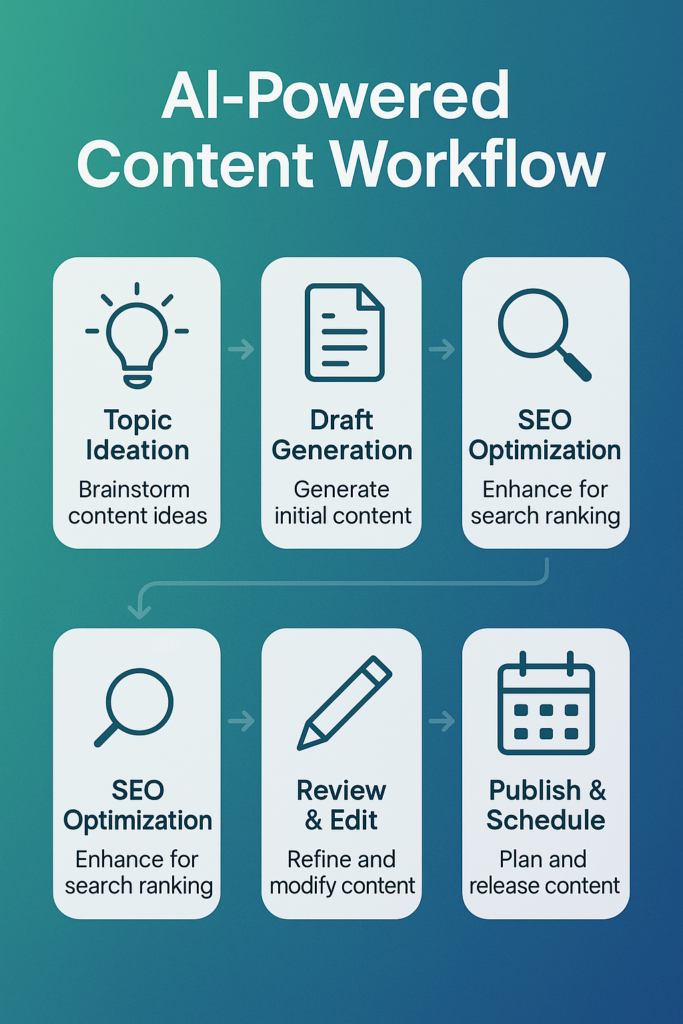
Automated Copywriting Workflows
Once you’ve got a topic, ai copywriting tools are like turbocharged typewriters: they draft paragraphs, suggest transitions, and even punch up calls to action. You can feed them bullet‑point outlines—key facts, angles, tone—and they’ll generate full sentences or entire sections in seconds. Need a catchy email subject? AI offers A/B‑tested options. Want to adapt a blog post into social snippets? It repackages your text into tweet‑sized or LinkedIn‑ready formats. Think of how it was just a year or so ago to be able to build complex pages, posts, and or books for that matter.
These workflows cut your draft time by up to 70%, letting you focus on injecting your unique voice and brand story. Best of all, most platforms include editing dashboards where you can tweak tone, adjust length, and ensure brand consistency. The result? A streamlined content production and Use AI to Elevate Your Web Marketing Strategy keeps everything humming without sacrificing quality or creativity.
SEO Keyword & On‑Page Optimization
SEO isn’t set‑and‑forget. AI‑driven SEO tools act like tireless editors, scanning your draft to ensure every page meets best practices. They suggest primary and secondary keywords based on search intent, recommend ideal heading structures, and even generate meta titles and descriptions optimized for click‑throughs.
Some tools analyze your competitors’ top‑ranking articles in real time, highlighting word‑count gaps and backlink opportunities.
On‑page optimization also covers internal linking—AI can map out your site’s content silo and suggest links that boost user journeys and raise page authority. Use ai to Elevate Your Web Marketing Strategy along with good SEO workflow, you avoid endless manual checks and ensure each piece aligns with your overarching web marketing strategy, helping you climb search rankings faster and more reliably.
AI‑Driven Visual Asset Generation
Words need visuals to stand out. AI image generators create custom graphics—infographics, hero images, social banners—based on your prompts. Tell the tool “vintage‑style infographic showing five steps of content creation” or “modern illustration of a chatbot conversation,” and it produces on‑brand visuals in minutes.
Beyond static images, AI can generate short video loops or animated GIFs, perfect for social posts or landing pages.
This capability eliminates dependence on stock libraries and speeds up asset creation, The use ai to Elevate Your Web Marketing Strategy comes into play here and offers more visually engaging assets without ballooning design costs or timelines.
Real‑Time Content Performance Tracking
After publishing, AI switches roles to become your watchdog, continuously monitoring metrics like page views, scroll depth, time on page, and conversion rates. Dashboards update in real time, and custom alerts notify you when a post spikes or dips in performance. Some platforms even recommend adjustments—like tweaking a headline or refreshing an old post—to keep content fresh and relevant.
This immediate feedback is great for tweaking your web marketing strategy. Instead of waiting weeks for monthly reports, you see what’s working now and act on it instantly.
It’s like driving with live traffic updates—you can reroute on the fly, avoid bottlenecks, and reach your destination faster.
Personalization & Customer Segmentation with AI
Imagine speaking directly to each visitor as if you know them personally—that’s the power when you Use ai to Elevate Your Web Marketing Strategy. In this section, we’ll cover five critical steps:
- Basics of Data‑Driven Segmentation: How to collect and organize customer data—demographics, behavior, purchase history—into meaningful groups.
- Machine‑Learning Models for Personas: Using clustering algorithms to discover hidden audience segments you might never spot by eye.
- Behavioral vs. Psychographic Targeting: The difference between “what people do” and “why they do it,” and why both matter.
- Delivering Dynamic Content Experiences: How to swap headlines, images, or offers on the fly based on each visitor’s profile.
- Measuring Personalization Impact: Which metrics prove that your tailored messaging is paying off, and how to optimize next steps.
Together, these five topics form a playbook: first gather data, then let AI group and profile your audience, craft messages that speak to their actions and motivations, serve dynamic pages that adapt instantly, and finally measure the lift so you can double down on what works.
Use ai to Elevate Your Web Marketing Strategy to shift from very basic to one‑to‑one conversations, improving engagement, and conversions. Let’s start by mastering the art and science of segmentation.
Basics of Data‑Driven Segmentation
Segmentation is simply grouping your audience into buckets with shared traits. With AI, you automate this process at scale. First, gather data from every touchpoint: website analytics, CRM records, email interactions, and purchase histories. Clean it—remove duplicates, fix typos, and normalize formats—so your AI model doesn’t learn from garbage.
Next, feed the data into a clustering algorithm—like K‑means or hierarchical clustering. The model examines each user’s data points and groups them by similarity. You might end up with segments such as “frequent browsers,” “first‑time buyers,” or “cart abandoners.”
Unlike manual segmentation, ai can process dozens of variables simultaneously—geography, device type, referral source—and detect nuanced patterns.
Finally, label each segment clearly and map them to your marketing goals. For example, “cart abandoners” get reminder emails, while “first‑time buyers” see welcome discounts.
By automating segmentation, you can rest assured that visitors receive messages that match their needs, rather than generic blasts. This data‑driven approach is the foundation of any ai‑powered web marketing strategy, turning raw numbers into actionable audience profiles.
Machine‑Learning Models for Personas
Personas craft narratives around your segments: who they are, what they want, and how they behave. AI takes persona creation beyond guesswork. You start by feeding a machine‑learning model all your customer data—demographics, browsing paths, purchase patterns, even support tickets. The model then identifies coherent clusters that reveal natural personas.
For instance, one cluster might represent “Budget‑Minded Millennials” who browse deals late at night, while another shows “Luxury Shoppers” who view high‑end items but convert slowly. ai models uncover these personas by analyzing correlations: perhaps price sensitivity correlates with certain product categories or time of day.
Once personas emerge, document them with names, pain points, and typical journeys. Then, tailor your web marketing strategy—email sequences, landing pages, and retargeting ads—to each persona’s narrative. Because ai personas are grounded in real data, your messaging feels authentic and resonates deeply. In your marketing canvas, you move from broad strokes to fine brushwork.
Behavioral vs. Psychographic Targeting
This is a neat section about behavioral targeting, which focuses on what users do—pages viewed, buttons clicked, items in cart. Psychographic targeting digs into why they do it—their values, interests, and motivations. Both are essential, and AI helps you combine them seamlessly.
With behavioral data, ai tracks real‑time actions and triggers immediate responses. For example, if someone views product A three times, ai can serve a related case study or demo offer. Psychographic data, on the other hand, comes from surveys, social‑media analysis, and sentiment tools. I know what your saying getting people to fill out surveys can be a chore. ai reads social chatter to gauge values like sustainability or innovation, tagging users accordingly.
By merging these layers, you can create messages that speak to both the visitor’s actions and their mindset. A tech‐savvy shopper (psychographic) who abandons a high‑end gadget (behavioral) might receive a deep‑dive video and a limited‑time trial. Videos work, plain and simple, use them.
This dual targeting, powered by ai, elevates your web marketing strategy from transactional to relational, building trust and driving loyalty.

Are you interested in maximizing your online growth? We can help you
Use ai to Elevate Your Web Marketing Strategy: Web Design, SEO, and Content Writing. Talk to Us! Call: (857)400-8959
Delivering Dynamic Content Experiences
Static web pages feel the same to every visitor. ai flips the script by serving dynamic content—text, images, and offers that adapt on the fly. Imagine your homepage greeting first‑time visitors with a “Welcome” banner and a free guide, while returning buyers see “Recommended for You” product carousels.
Under the hood, ai uses your segmentation and persona data to choose which module to render. Tools like dynamic tag managers or server‑side personalization engines swap content blocks in real time. The result?
Each visitor sees the most relevant message without any delay.
Implementing dynamic experiences usually involves adding a small personalization script to your site and defining rules in your AI platform. Test different variants and let ai optimize the mix by measuring engagement. Dynamic content makes your web marketing strategy feel like a personal concierge—improving conversions and delighting visitors.
Measuring Personalization Impact
Personalization is only worthwhile if it moves the needle. ai platforms provide dashboards that track lift metrics—like click‑through rate changes, conversion rate improvements, and average order value differences between personalized and control groups.
Set up A/B or multivariate tests: serve personalized content to 50% of traffic and generic content to the other half. ai tools collect results and run statistical analyses to determine significance. Look at KPIs such as engagement time, goal completions, and revenue per visitor.
Beyond immediate metrics, track long‑term effects on customer retention and lifetime value. Personalized experiences often boost loyalty, leading to repeat purchases. Use cohort analysis to see if personalized segments outpace others over weeks or months.
By continuously measuring and feeding results back into your AI, you create a virtuous cycle—data improves models, models drive better personalization, and better personalization generates more data. This iterative loop ensures your web marketing strategy stays razor‑sharp.
Measuring Success & Continuous Improvement in Your ai Web Marketing Strategy
You’ve set up your ai engines, tweaked campaigns, and streamlined processes—but how do you know it’s working? Please message me to understand how AI can help you with your media campaigns.
In this final section, we’ll cover five steps to measure performance and keep improving:
- Defining AI‑Centric KPIs: Identify the key metrics—CTR, conversion lift, cost per acquisition—that matter most to your goals.
- Building an AI‑Powered Dashboard: Aggregate data from all channels into a single, real‑time view that highlights wins and red flags.
- Experimentation & Iteration Frameworks: Set up a process for running continuous tests, learning from failures, and iterating on successes.
- Feedback Loops for Model Refinement: Feed performance data back into your AI models so they learn and improve over time.
- Scaling & Governance: Decide how you would like to expand AI across teams responsibly, maintaining data security, ethical guidelines, and budget controls.
By mastering these five areas, you’ll transform your web marketing strategy into a self‑optimizing system—one that learns, adapts, and scales without constant manual oversight. Let’s explore each step in detail, starting with choosing the right KPIs.
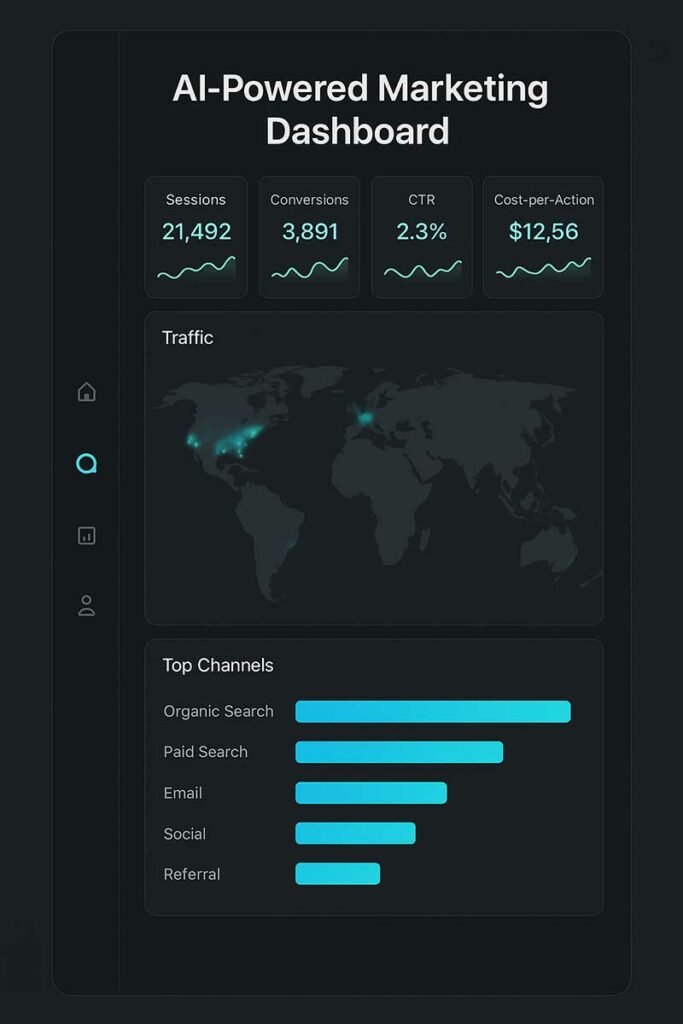
Defining AI‑Centric KPIs
Not all metrics are created equal. For an AI‑enhanced web marketing strategy, prioritize KPIs that reflect gains and revenue impact. Common choices include:
- Click‑Through Rate (CTR): Measures how compelling your creatives and messaging are.
- Conversion Rate Lift: Compares conversions before and after AI optimizations.
- Cost Per Acquisition (CPA): Tracks how much each new customer costs you, factoring in AI-driven spend.
- Engagement Time: Indicates content resonance—longer sessions often signal stronger interest.
- Prediction Accuracy: For predictive models, monitor how often the AI’s forecasts match real outcomes.
Define benchmarks and set realistic targets (e.g., 15% CTR improvement or 20% CPA reduction). These metrics keep everyone aligned—marketing, sales, finance—on what success looks like. As you roll out AI, revisit KPIs quarterly to ensure they still match evolving business goals.
Building an AI‑Powered Dashboard
Siloed reports breed confusion. An ai‑powered dashboard centralizes data from your CMS, ad platforms, social channels, and email tools. Use visualization widgets like line graphs for trends, bar charts for channel comparisons, and heat maps for regional performance. Include drill‑down capabilities—click a KPI to see underlying segments and time frames.
Platforms like Domo, Tableau, or Google Data Studio integrate with AI engines via APIs, delivering real‑time insights. You can set threshold alerts (e.g., CPA spikes above $50) that send notifications. This unified view becomes your command center, letting you spot anomalies and opportunities instantly—turning data into action for your web marketing strategy.
Experimentation & Iteration Frameworks
AI thrives on continual learning, which demands a structured testing process. Adopt an experimentation framework like PI ROCE (Plan, Implement, Review, Optimize, Continue, Expand). For each test—say, a new ad copy—define hypothesis, success criteria, and test duration. Use ai tools to randomize traffic splits and collect results.
After the test, review outcomes against KPIs. Did the new copy lift engagement? If so, expand its use; if not, analyze why and pivot. Document every experiment in a living playbook.
This measured approach ensures your web marketing strategy evolves methodically, leveraging AI’s speed while maintaining human oversight.
Feedback Loops for Model Refinement
AI models aren’t “set-and-forget.” Continual refinement requires feeding them fresh performance data—conversion results, click patterns, and customer feedback. Set up automated pipelines that push sanitized data back into your AI platform daily or weekly.
For example, if your predictive model overestimates open rates by 10%, retrain it with the new data to correct biases. Document all changes and monitor how accuracy improves over time.
The feedback will guarantee your web marketing strategy becomes smarter each cycle, aligning predictions ever closer to real-world outcomes.
Scaling & Governance
As ai proves its worth, you’ll want to expand beyond marketing into sales, support, and product teams. But scaling responsibly is crucial. Establish governance policies covering data access, privacy compliance (GDPR, CCPA), and ethical guidelines (no discriminatory targeting).
Define budget guardrails—caps on ad spend or API usage—to prevent runaway costs.
Train additional team members on AI best practices and create an internal steering committee to oversee expansions. With governance in place, you can multiply AI’s benefits across your entire organization while safeguarding trust and compliance.
That wraps our deep dive into Smart Moves: How to Use AI to Elevate Your Web Marketing Strategy
If you follow these steps—auditing, tool selection, AI‑powered content, personalization, paid‑media optimization, social engagement, and measurement—you’ll develop a web marketing strategy that’s not just modern but future‑proof.
Now it’s your turn: put these insights into action and watch your results soar. Need help? Contact us!
Stay connected
We’re always hard at work putting out new content covering WordPress, marketing, and SEO news. Stay connected with us 100% spam FREE.
We hope that you enjoy our content. If you decide to make a purchase after clicking on one of our affiliate links, we’ll earn a small commission at no extra cost to you. Thanks for reading! View our Affiliate Disclosure


Great read. AI is a force multiplier when it accelerates research, drafts, and analysis—not when it replaces judgment.